
Brecon Cathedral, home to Britain’s largest Norman font
ANCIENT BRITONS, ROMANS and Normans, each have left their calling cards at BRECON. The huge Iron Age hill fort of PEN-Y-CRUG, on a hill just to the north of the present town, has a circumference of 1,650 ft (503 m) and ramparts 18 ft (5.5 m) high. A little to the west is BRECON Y GAER, THE LARGEST ROMAN FORT OF ITS TYPE IN WALES. Remains of the castle, begun in 1093 by the Norman baron Bernard de Neufmarche, can be found in the Bishop’s Palace gardens and in the garden of the Castle Hotel.
Brecon sits in its own green bowl of hills, where three rivers meet, the Usk, the Tarrell and the Honddu, and where all ways converge, mountain, valley and road. Cut off from the rest of the world by the Black Mountains and the Brecon Beacons, it has the aspect of a Welsh agricultural market town, yet feels like an English cathedral city. At the centre of the town, traffic swirls around St Mary’s parish church, while narrow streets and passageways lined with Jacobean shop fronts dive down to the river or straggle up the hill.
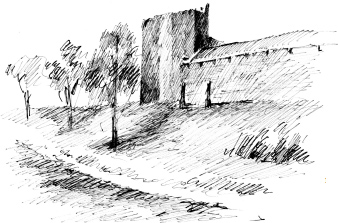
Once it dawns that St Mary’s is not the cathedral, it is but a short steep walk up the hill, past the massive battlemented wall of the medieval priory close, to the attractive lich-gate leading into the cathedral close.
The ‘Church of St John the Evangelist Without the Walls’ was founded sometime after 1093, as a Benedictine monastery, by Bernard de Neufmarche’s confessor, a monk from Battle Abbey in Sussex. All that remains from the original Norman structure is the magnificent font, elaborately carved with extraordinary birds and beasts. The present building, most of which dates from the 13th and 14th centuries, is 205 ft (62 m) in length, solid and well-proportioned. The chancel, dating from 1201, is one of the most sublime examples of Early English architecture to be found in any British cathedral.
In the baptistry can be found THE BIGGEST CRESSET STONE IN BRITAIN, with 30 cups. A cresset stone is an ancient form of lighting, a large stone slab with a number of chambers scooped out of it, in which to put candles.
The elegant five-lancet east window commemorates the officers and men of the 24TH REGIMENT (SOUTH WALES BORDERERS) who lost their lives in the Zulu War of 1879. In the Havard Chapel on the north side of the chancel, now the Regimental Chapel of the South Wales Borderers (since amalgamated into the Royal Regiment of Wales), there hangs the Queen’s Colour of the 1st Battalion 24th Regiment. This was recovered after the Battle of Isandlhwana, having been gallantly defended by Lieutenants Melvill and Coghill at the cost of their own lives. Each was awarded a posthumous Victoria Cross in 1907.
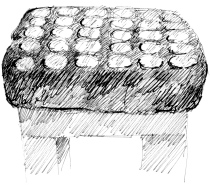
The barracks of the South Wales Borderers is down in the town. The museum houses mementoes of their heroic defence of the British supply base at Rorke’s Drift in January 1879, when 104 men held off 4,500 Zulu warriors for more than 12 hours, until relieved at seven o’clock in the morning. Eleven Victoria Crosses were won at Rorke’s Drift, including seven for men of the ‘Old 24th’, THE LARGEST NUMBER OF VCS EVER AWARDED TO A SINGLE REGIMENT FOR ONE ACTION. The classic film Zulu, that tells the story of the battle, was made in 1964 and starred Michael Caine and Stanley Baker.
A noted occupant of the delightful Prior’s House beside the cathedral was SIR JOHN PRICE (1502–55), church commissioner for Wales and the man given responsibility for dissolving the monasteries in Wales in 1537. He was the author, in 1547, of THE FIRST BOOK TO BE PRINTED IN WELSH, Yn y Lhyvyr hwnn, an instruction manual for the Welsh priesthood.
Another Price from Brecon, DR HUGH PRICE, founded Jesus College, Oxford, in 1571, primarily for students from Wales. The college still maintains strong links with Wales.
THE FIRST OFFICIAL WELSH SETTLER IN AMERICA, HOWELL POWELL, was from Brecon. He left for the state of Virginia in 1642.
SARAH SIDDONS (1755–1831), regarded as the greatest actress of her day, was born Sarah Kemble in the Shoulder of Mutton Inn, now the Sarah Siddons, on Brecon High Street. The inn sign is a reproduction of a portrait of the actress by Gainsborough. Sarah’s brother Charles Kemble (1775–1854), an equally famous actor in his day, was also born in Brecon.

THE NAME OF the pub in CILMERY gives a clue to the significance of this little village on the River Irfon, to the west of Builth Wells. It is called the Prince Llewelyn, in honour of LLYWELYN AP GRUFFUDD, THE LAST WELSH-BORN PRINCE OF WALES, who was killed in a skirmish here in 1282.
No one really knows what happened, but somehow Llywelyn became separated from his men and was run through by an English soldier, who stumbled upon him in woods down by the river. According to some sources, the soldier at first failed to realise whom he had killed, until he rummaged through Llywelyn’s clothes and came across some precious items, including a leather pouch with some splinters of wood inside it. This was recognised by the priest who came to bless the body as one of the great treasures of Gwynedd, fragments of the True Cross, known as the Cross of Gneth. Whether this tale is true or not, the Cross of Gneth ended up in the English treasury, and was given by Edward III to be displayed in St George’s Chapel at Windsor Castle. It did not survive the Reformation.
A 15 ft (4.6 m) high monument of Caernarfonshire granite has been erected near the spot, encircled by 13 oak trees planted in 1952 to represent the 13 historic Welsh counties.

NOBODY HAS YET been able to disprove the claim of LLANWRTYD WELLS, population 700, to be THE SMALLEST TOWN IN BRITAIN. It is indisputably the home of the annual WORLD BOG SNORKELLING CHAMPIONSHIPS, held in August, whereby competitors must race for two lengths of a 180 ft (55 m) cutting through the peat bog, wearing flippers and a snorkel – but without using normal swimming strokes. Other competitions held in the town include the Man versus Horse race in May and the Real Ale Wobble – which can happen at any time.
The well at Llanwrtyd is THE MOST SULPHUROUS IN WALES and was publicised by the historian Theophilus Evans (1693–1767), when he wrote about how the waters had cured his scurvy.
SOSPAN FOCH (Little Saucepan), the Welsh rugby anthem (see Carmarthenshire), was composed by Talog Williams and the Revd D.M. Davies while they were staying in Llanwrtyd Wells in 1895.

TREFECA MUST HAVE come as quite a surprise to anyone strolling through the green foothills of the Black Mountains, north-west of Brecon, in the middle of the 18th century. HOWELL HARRIS, leader of the great Methodist Revival in Wales, was born here in 1714, and later in life he extended and redesigned the property in pure ‘Strawberry Hill’ Gothick style, as a home for his ‘family’ of followers.
It all began on Palm Sunday in 1735, in St Gwendoline’s Church at Talgarth, just up the road. ‘I felt suddenly my heart melting within me like wax before a fire, with love to God my Saviour.’ This experience spurred Harris on to become a preacher, and he went off to travel many hundreds of miles through Wales on foot, preaching in the open air to vast crowds.
In 1752 he withdrew to his home at Trefeca and founded his ‘Connexion’, a self-sufficient religious community, part monastic, part co-operative. They looked after themselves and shared everything, while all practising different crafts and trades, in what John Wesley called a ‘little paradise’. Life was actually pretty tough, with everyone rising at 4 a.m. and working, either in the fields or in the workshops, until 11 p.m., stopping only to pray three times a day. In the main communal room an all-seeing eye was painted on the ceiling, and there were spy-holes through which Harris could keep an eye on his flock.
Amongst other things, Harris was an innovative agriculturalist, who introduced the turnip to Wales and co-founded the BRECONSHIRE AGRICULTURAL SOCIETY, THE FIRST OF ITS KIND IN WALES. He also pioneered new printing methods with his Trefeca Press, and many of the pamphlets and religious tracts he printed can be seen in the fascinating museum dedicated to his life, housed in the memorial chapel. Although his bombastic ways upset many, his funeral at St Gwendoline’s in 1773 was attended by over 20,000 people. Inside the church there is a huge, black, commemorative tablet near the communion table, marking his burial place, which attracts its fair share of pilgrims even now.
Still in use as a retreat, Trefeca is now a Lay Training Centre for the Presbyterian Church of Wales. Unfortunately, much of Harris’s Strawberry Hill confection has been subsumed over the years into a bland block of unimaginative white buildings, but the quiet atmosphere and the silence amidst the surrounding hills is wonderfully restful.
THE FAIRYTALE PINNACLES and turrets of neo-Gothic CRAIG-Y-NOS CASTLE nestle in a remote and ravishing valley beneath the bare slopes of Fforest Fawr, south-west of Brecon. Built by Thomas Wyatt in 1840 for Captain Rhys Powell, CRAIG-Y-NOS, or ‘Rock of the Night’, became a magnet for European society as the home for 40 years of the singer ADELINA PATTI (1843–1919), described by Verdi as ‘the finest soprano of her age’. The Queen of Song came to live in the Land of Song in 1878, with her lover and future husband the tenor Ernesto Nicolini. She was drawn by the pure mountain air, the dramatic scenery, and the opportunity to create her own private musical kingdom, where she could rest and recharge after her exhausting tours of the opera houses and salons of the world.
Born in Madrid, the fourth of six children, to a Sicilian father and an Italian mother both involved in opera, Adelina soon began to beguile with her clear, pure voice. At the age of 19 she sang ‘Home Sweet Home’ at the White House and reduced Abraham Lincoln and his wife to tears – they were in mourning for their son, who had just died of typhoid. ‘Home Sweet Home’ became her most requested song. She performed before all the crowned heads of Europe, including the Kaiser, the Tsar and Queen Victoria, sang at Rossini’s funeral, married Napoleon III’s equerry, and became one of the world’s richest women – for one performance of La Traviata in Boston she was paid $5,000, more or less what she paid for Craig-y-Nos.

Adelina Patti was a generous and popular chatelaine. She would arrive at Craig-y-Nos rather like Queen Victoria arriving at Balmoral, travelling in her own special train to the tiny station at Penwyllt, and being borne along to the castle down a private road lined with cheering crowds. She lavished a fortune on the estate, laying out gardens and installing all the latest technology – Craig-y-Nos was ONE OF THE FIRST PRIVATE HOUSES IN BRITAIN TO HAVE ELECTRICITY.
On 19 June 1886, most of South Wales turned out to see her marry Ernesto Nicolini at the tiny St Cynog’s Church in the nearby village of Ystradgynlais. Afterwards, at the reception, over 100 local people enjoyed dinner in the castle’s banqueting hall, there were fireworks and dancing until dawn, and a giant bonfire was lit on the mountainside above.
They all came to see Patti at Craig-y-Nos – the Crown Prince of Sweden, Prince Henry of Battenberg, the Prince of Wales, (later Edward VII), and, in 1891, Baron Julius Reuter, the founder of Reuter’s News Agency, who officiated at the opening of her new private theatre, modelled on the Theatre Royal Drury Lane. The theatre is still used today for opera and remains one of the most perfect examples of a state-of-the-art working Victorian theatre surviving in Britain.
Adelina Patti died in 1919 at Craig-y-Nos and is buried close to Rossini in the Père Lachaise cemetery in Paris.
The southern fringe of the Brecon Beacons National Park is renowned for its limestone caves, and Craig-y-Nos sits right in the middle of some of the best caving country in Britain. The caves of DAN-YR-OGOF at the National Showcaves Centre to the north are ‘BRITAIN’S LARGEST AND LONGEST SHOWCAVES’, and are family friendly with lighting, concrete steps and handholds. They were first properly explored in 1912, and so far over 10 miles (16 km) of caverns have been discovered. Weddings are held in the vast Cathedral Cave. In the Bone Cave 42 human skeletons were found.
Further south, towards Abercraf, and for more experienced cavers only, is OGOF FYNNON DDU, at 1,010 ft (308 m) THE DEEPEST CAVE IN BRITAIN, and the third longest, with over 30 miles (48 km) of passages.
A little to the east, running in a dead straight line from near the village of Coelbren towards Ystradfellte, there is a remarkably untouched stretch of Roman road, dating from around AD 74, when the Romans conquered Wales. It crosses the bare exposed moorlands of Fforest Fawr, passing on the way a 9 ft (2.7 m) high standing stone called MAEN MADOC, which bears an incomplete Latin inscription that translates as ‘… of Drevacus, son of Justus. He lies here’.
PORTH-YR-OGOF, meaning ‘gateway to the cave’, lies south of the mountain hamlet of Ystradfellte, and is THE LARGEST CAVE ENTRANCE IN WALES, one of the largest in Britain. Once inside there are some 2 miles (3.2 km) of caves to explore, and Porth-yr-Ogof remains very popular with cavers, despite the fact that the cave system here has claimed more lives than any other cave in Britain, with ten deaths in 50 years.
This area of Breconshire is also known as waterfall country, and at SGWD Y EIRA, the ‘Waterfall of Snow’, just to the south of Porth-yr-Ogof, you can follow a path behind the falls, an exhilarating experience.
Travelling east, beyond the Brecon Mountain Railway, to the east of Garn Fawr on Mynydd Llangynidr, is the CHARTIST CAVE, where Chartist meetings were held and weapons were stockpiled prior to the march on Newport in November 1839 (see Monmouthshire). The entrance has crumbled somewhat and access is difficult.
Further east, underneath MYNYDD LLANGATWG, south of Crickhowell, is THE LARGEST CAVE SYSTEM IN EUROPE, discovered in 1960 by students from the University of Wales. It can be accessed from Llangattock.
South of Mynydd Llangatwg, in CLYDACH GORGE, there is a FAIRY GLEN and SHAKESPEARE’S CAVE, which has led many to speculate that this is where William Shakespeare wrote A Midsummer Night’s Dream. Certainly the wild and mystical atmosphere here can inspire fantastical visions of fairies and star-crossed lovers. It is believed that Shakespeare came to explore the gorge while staying with friends at Trebarriad House, north of Brecon. The house in which the Bard stayed was subsequently replaced with a quite exceptionally beautiful Jacobean mansion that has been recently restored.

Trebarriad House
FRAMED BY THE Abergavenny Sugar Loaf and the dramatic Table Mountain, Crickhowell is one of the most delightful small market towns in Wales. The 17th-century bridge across the River Usk here is THE LONGEST STONE BRIDGE IN WALES. A pleasant diversion is trying to solve the conundrum of Crickhowell Bridge – seen from the eastern end it has 13 arches, but seen from the western end it only has 12.
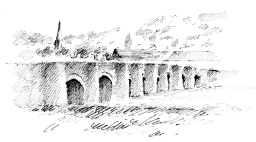
Just outside Crickhowell, to the west, is a fine Georgian house called GWERNDALE, now a hotel, where SIR GEORGE EVEREST (1790–1866) was born. He was appointed Surveyor-General of India in 1830, and the pioneering triangulation methods he developed for his work were used by his successor, Andrew Waugh, in 1852 to calculate the height of the highest mountain in the world. In tribute to Sir George Everest, ‘that illustrious master of geographical research’, as Waugh described him, the world’s highest peak was given the name MT EVEREST.
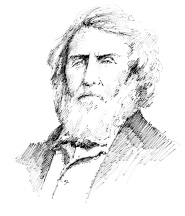
High in the hills behind Crickhowell, on a slope above the valley of the Grwyne Fawr, is one of those heavenly places that you can only find in Wales. Slumbering peacefully at the end of a steep mountain track, embowered in its own patch of green churchyard, bedecked with flowers and unbelievable views, is the little church of PARTRISHOW, no more than a tumble of stones, huddled up against the wind. A little stream burbles nearby, and a spring. Stone seats run along the church wall facing a tall, wonderfully preserved preaching cross. As the door of the church swings open it is hard not to gasp at the treasures revealed. An unpainted screen and balustrade of Irish oak, exquisitely carved with dragons and vines, that served as a 15th-century storybook for a congregation long gone. A font with an inscription that dates it to circa 1055, and, behind it, the medieval hermit’s cell belonging to St Ishow. There is also an early mural of a Doom figure on the west wall.
It must be the isolation that has protected these wonders from the Reformation, from Cromwell’s soldiers, from vandals. Partrishow is hard to find but even more difficult to leave.

ON THE BANKS of the River Wye between Builth Wells and Brecon is LLANGOED HALL, thought to be built on the site of the fabled White Palace, home of the first Welsh Parliament in the early 6th century. In AD 560 the palace was passed over to the See of Llandaff by Prince Iddon, who wished to earn forgiveness for his wrongdoings, and it evolved into an Episcopal Grange. By 1632 the Grange had become dilapidated, and a splendid pile was then built from the ruins for Sir Henry Williams, whose coat of arms can be found above the surviving Jacobean porch.
In 1880 the house was won in a game of poker by a John Macnamara, and then, in 1912, the new owner Sir Archibald Christie asked Clough Williams-Ellis to redesign and extend the property. This was Clough Williams-Ellis’s first major commission and shows many of the characteristics and tricks he would later use to great effect when designing his masterpiece at Portmeirion (see Merioneth). Llangoed Hall eventually fell into a terrible state of neglect and was rescued from demolition in the 1980s by SIR BERNARD ASHLEY, who turned it into a country house hotel to showcase his wife’s Laura Ashley Fabrics.
THE NARROW ROAD along the Vale of Ewyas from Abergavenny to Hay-on-Wye, past Llanthony Priory and up over Hay Bluff, is one of the most gorgeous roads in Britain. About 4 miles (6.4 km) west of Llanthony, just as you cross the border from Monmouthshire into Breconshire, lies the tiny community of CAPEL-Y-FFIN, which means ‘chapel on the border’. There is a beautiful little chapel of ease here, white, with a crooked, wooden belfry, surrounded by ancient yew trees. Just off the road is a small group of Italianate buildings with a statue of Jesus outside. This is ‘Llanthony Tertia’, a Benedictine monastery founded in 1870 by an Anglican priest, Joseph Leycester Lyne, known as Father Ignatius. He had wanted to buy the original Llanthony Priory ruins but was thwarted, and so he decided to build his own retreat, where he lived in contented seclusion with a small community of like-minded fellows. The buildings were never completed, and when Father Ignatius died in 1908 the monks of Caldey Island, near Tenby, took over the monastery.

In 1924 the eccentric sculptor and artist ERIC GILL (1882–1940) bought the crumbling monastery buildings and moved to Capel-y-Ffin with some of his exotic retinue of animals, family and craftsmen, from their commune at Ditchling in Sussex. They lived as self-sufficiently as they could, growing their own food and making their own furniture. It was while living at Capel-y-Ffin that Gill designed what he is perhaps best remembered for, apart from his controversial life-style, the classic GILL SANS typeface. Acknowledged as THE FIRST BRITISH MODERNIST TYPE DESIGN, Gill Sans was used on the covers of pre-war Penguin books, and by British Railways, and was chosen for the BBC logo in 1997. Amongst his major sculptures are Ariel and Prospero on Broadcasting House in London’s Portland Place, the East Wind sculpture over the entrance to St James’s Park underground station, and the Stations of the Cross in Westminster Cathedral.
Eric Gill only stayed at Capel-y-Ffin for four years from 1924 until 1928, but a good deal of his best work was accomplished here, so the solitude and invigorating air must have been great inspiration. In his autobiography, much of which he wrote here, Gill recalls his days at Capel-y-Ffin as the happiest time of his life, and he returned frequently to visit his daughter Betty, who stayed on with her family. Examples of his calligraphy can be found on gravestones in the monastery and in the burial ground of the little white chapel. The monastery is privately owned but the remains of Father Ignatius’s unfinished church can be explored.
HAY-ON-WYE REVELS IN its claim to be THE SECOND-HAND BOOK CAPITAL OF THE WORLD. It is, however, no idle boast, for this small border town has 38 bookshops and was THE WORLD’S FIRST BOOK TOWN – there are now some 60 Book Towns across the world and the number is growing all the time.
It was all started by RICHARD BOOTH in 1961 when he opened his first bookshop in Hay, which soon grew into EUROPE’S LARGEST SECOND-HAND BOOKSHOP. His motto was that ‘you buy books from all over the world and your customers come from all over the world’. In the 1970s he came up with the idea of a Book Town and whipped up a lot of publicity on April Fool’s Day in 1977 by declaring Hay-on-Wye an independent kingdom, and proclaiming himself King of Hay.
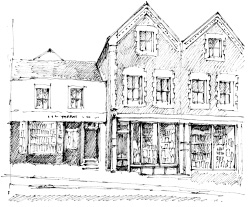
In 1988, the first Hay Literary Festival was held and this has since grown into one of Europe’s premier literary occasions, attracting 100,000 visitors and top writers to the town. The star speaker in 2002 was former US President Bill Clinton.
Books aside, Hay is a fascinating ancient town clustered around a Norman castle, on one of the most beautiful stretches of the River Wye. It is full of tempting narrow streets, half-timbered houses, cosy pubs and restaurants and a slightly musty, intellectual, other-worldly atmosphere that is highly seductive.
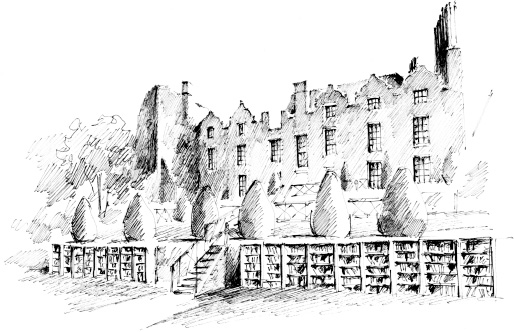
The 520 sq. mile (1,346 sq. km) BRECON BEACONS NATIONAL PARK, established in 1957, was THE FIRST NATIONAL PARK IN WALES. Today, Wales’s three National Parks and five Areas of Outstanding Natural Beauty cover 23 per cent of the country.
At 2,906 ft (886 m) PEN Y FAN in the Brecon Beacons is THE HIGHEST POINT IN SOUTHERN BRITAIN.
BRYNMAWR, on the southern slopes of Mynydd Llangattock, is 1,350 ft (411 m) above sea level, THE HIGHEST TOWN IN WALES.
BUILTH WELLS claims to possess the only Post Office that was opened in Britain during the short reign of Edward VIII.
Beside the A40 near Halfway, equidistant from Trecastle and Llandovery, is one of the first drink driving warning signs, a striking obelisk known as the ‘COACHMAN’S CAUTIONARY’. It commemorates a disaster which took place in 1835 when a stagecoach full of passengers, with a drunk driver at the reins, careered over the edge and rolled down the hill into the river.
HEOL SENNI, a tiny village south of Sennybridge, was the birthplace of the RT REVD W.T. HAVARD, THE ONLY BISHOP TO PLAY RUGBY FOR WALES. He was capped in 1919, before going on to become Bishop of St Asaph.
On 14 December 2000, the WELSH WHISKY COMPANY began producing whisky in the pretty village of PENDERYN on the Glamorgan border. This was the first whisky to be produced in Wales since the closure of the Frongoch distillery near Bala in 1894 – as a result of a ‘chapel building’ religious revival which encouraged temperance (see Merioneth). The design of the purpose-built new distillery at Penderyn is based on that of the old 19th-century distillery at Frongoch. In the early 18th century, there was a small distillery at Dale in Pembrokeshire, owned by Evan Williams, whose family emigrated to America and helped to found the Kentucky Whiskey industry. The new Welsh Whisky single malt is matured in Jack Daniels and Evan Williams casks – a fitting tribute to the Welsh pioneers of bourbon.
The BRECON MOUNTAIN RAILWAY which runs between Merthyr Tydfil and the Taf Fechan reservoir is the only one of Wales’s ‘Great Little Railways’ located in South Wales.
LLANGORS LAKE, south-east of Brecon, is THE SECOND LARGEST NATURAL LAKE IN WALES.
The Iron Age hill fort of CASTELL DINAS, near Talgarth, occupies THE HIGHEST CASTLE SITE IN WALES, 1,476 ft (450 m) above sea level.